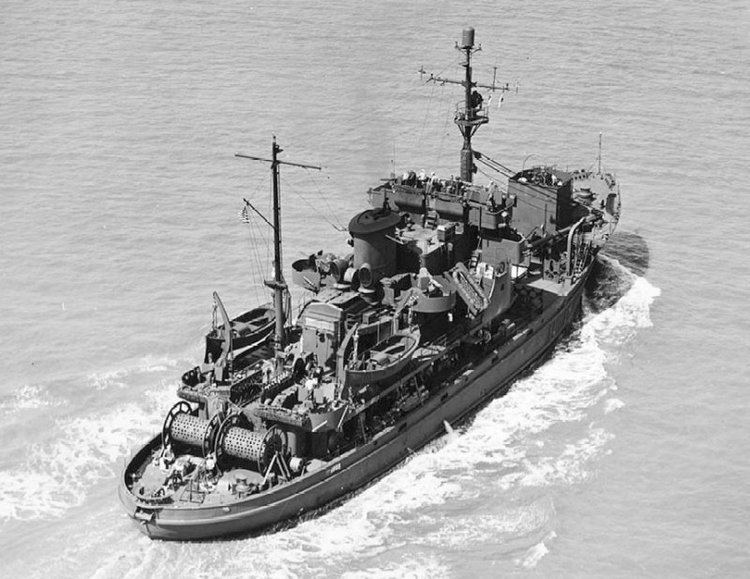Name USS Trapper (ACM-9) Decommissioned 20 June 1946 Launched 15 March 1945 | Acquired 2 January 1945 Struck 19 July 1946 Length 57 m | |
 | ||
Builder Marietta Manufacturing Company, Point Pleasant, West Virginia Laid down 1942 as USAMP Maj. Gen. Arthur Murray for the U.S. Army | ||
USS Trapper (ACM-9) was a Chimo-class minelayer in the United States Navy in World War II.
Contents
- Pacific Theatre operations
- Transfer to the US Coast Guard
- Reacquisition by the US Navy
- Final decommissioning
- References
Trapper was built 1942 for the United States Army as U.S. Army Mine Planter (USAMP) Maj. Gen. Arthur Murray at Point Pleasant, West Virginia, by the Marietta Manufacturing Co.; acquired by the U.S. Navy on 2 January 1945; converted into an auxiliary minelayer by the Charleston Navy Yard, in South Carolina; and commissioned on 15 March 1945, Lt. Richard E. Lewis, USNR, in command. The ship later became U.S. Coast Guard cable ship USCGC Yamacraw (WARC-333) then, after being reacquired by Navy, the Cable Repair Ship USS Yamacraw (ARC-5).
The ship's namesake as an Army mine planter, MG Arthur Murray, USA, was the first Chief of Coast Artillery 1 July 1908 – 14 March 1911. The Army Mine Planter Service was part of the Coast Artillery Corps.
Pacific Theatre operations
After shakedown training in the Chesapeake Bay area during April, Trapper got underway on 11 June and proceeded – via Manzanillo, Cuba, the Panama Canal, and San Diego — to the Pacific Ocean war zone. In mid-August, while the minelayer was en route to Hawaii, Japan capitulated. The ship arrived at Pearl Harbor on 21 August and was routed westward, via Eniwetok, Saipan, and Okinawa, to Japan.
Trapper arrived at Kobe on 25 November 1945 and operated out of that port repairing minesweeping gear until 1 February 1946 when she shifted her base of operations to Wakayama for a month. On 11 March, the minelayer got underway for the United States. En route, she called at Saipan, Eniwetok, Kwajalein, Johnston Island, and Hawaii before arriving at San Francisco, on 2 May.
Transfer to the U.S. Coast Guard
Trapper was decommissioned and transferred to the United States Coast Guard on 20 June 1946 and struck from the Navy list on 19 July 1946. The former auxiliary minelayer served with the Coast Guard until early 1959 as the USCGC Yamacraw (WARC-333).
During 1957 and 1958 the ship was leased to Woods Hole Oceanographic Institution for geophysical research.
Before being transferred back to the U.S. Navy the Yamacraw was the buoy tender in the 1958 film Onionhead, which starred Andy Griffith and Walter Matthau.
Reacquisition by the U.S. Navy
She was reacquired by the United States Navy on 17 April 1959 and commissioned at New York on 30 April as ARC-5, a cable repair ship.
Yamacraw was assigned to the 3rd Naval District for the next six years. She operated from Portsmouth, New Hampshire, to Bermuda and spent much of her at-sea time conducting research projects for the Office of Naval Research and for the Bell Telephone Laboratories.
Final decommissioning
On 2 July 1965, Yamacraw was decommissioned, transferred to the permanent custody of the Maritime Administration, and struck from the Navy List.
